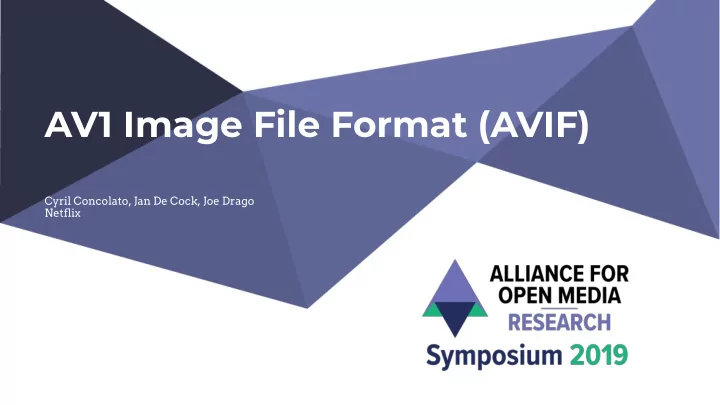

AV1 Image File Format (AVIF) Cyril Concolato, Jan De Cock, Joe Drago Netflix
Outline • Overview of the format • Compression and decoding speed evaluations • Conclusions
Technology stack (1) ISOBMFF Base elements ● ISO/IEC 14496-12 ○ Syntactical elements: “boxes”(e.g. MetaBox) Logical concepts: “tracks” and “items” ○ ○ Storage concepts: streaming, interleaving, ... IFF (HEIF) Image-specific and codec-agnostic definitions ● ISO/IEC 23008-12 image sequences vs image items ○ coded images ○ vs. derived images (crop, rotate, mirror) master images ○ vs. auxiliary images (alpha, depth) vs. thumbnail images image collection and alternate images ○ multi-layer images ○ overlayed images, image grid ○ metadata association ○
Technology stack (2) MIAF No new technology ● ISO/IEC 23000-22 ● Additional structural constraints on ISOBMFF/IFF Self-containment ○ ○ Single-layer present Thumbnail size and grid limitations ○ ○ Track limitations (same duration, loops) Alpha plane constraints (same codec) ○ ● Application-level constraints Progressive ○ ○ Animation Image Bursts ○ ○ Fragmented and fragmented alpha-video AVIF Mapping of AV1 KeyFrame /Temporal Units into items ● AOM specification and tracks Profiles (Basic and Advanced) ●
AVIF capabilities • 8, 10, 12 bits • Lossless or not • Monochrome (alpha/depth) or multi-components • Any color-space • ISO/IEC CICP (color, transfer, matrix, range) • ICC profiles • Chroma subsampling: 4:2:0, 4:2:2, 4:4:4. • HDR • Film-grain https://aomediacodec.github.io/av1-avif/
Comparison JPEG JPEG 2000 AVIF @ 0.5 bpp
Comparison @ 0.2 bpp JPEG
Comparison @ 0.2 bpp JPEG 2000
Comparison @ 0.2 bpp AVIF
AVIF HDR Image Visualizing HDR images ( https://medium.com/netflix-techblog/enhancing-the-netflix-ui-experience-with-hdr-1e7506ad3e8 ) More images: https://github.com/AOMediaCodec/av1-avif/tree/master/testFiles
Results
Results Low-res images (Kodak test set, 768x512) File size reduction vs. JPEG, 4:2:0 WebP JPEG 2000 HEVC AVIF VMAF = 75 -11.8% -35.7% -44.0% -47.7% VMAF = 85 -14.7% -30.8% -33.1% -37.7% VMAF = 95 -20.9% -25.0% -30.1% -36.7%
Results Low-res images (Kodak test set, 768x512) File size reduction vs. JPEG, 4:4:4 JPEG 2000 HEVC AVIF VMAF = 75 -46.4% -53.1% -55.4% VMAF = 85 -39.3% -41.4% -44.0% VMAF = 95 -23.1% -32.5% -38.7%
Results Low-res Netflix UI images (571x800) File size reduction vs. JPEG, 4:2:0 WebP JPEG 2000 HEVC AVIF VMAF = 75 -13.1% -45.5% -56.1% -63.2% VMAF = 85 -28.9% -29.4% -46.3% -53.6% VMAF = 95 -12.0% -12.8% -35.4% -43.3%
Results Low-res Netflix UI images (571x800) File size reduction vs. JPEG, 4:4:4 JPEG 2000 HEVC AVIF VMAF = 75 -46.4% -53.1% -55.4% VMAF = 85 -39.3% -41.4% -44.0% VMAF = 95 -23.1% -32.5% -38.7%
Results High-res images (Netflix UI billboard images, 2048x1152) File size reduction vs. JPEG, 4:2:0 WebP JPEG 2000 HEVC AVIF VMAF = 75 -24.5% -52.9% -56.3% -61.1% VMAF = 85 -20.7% -40.9% -44.6% -50.3% VMAF = 95 -19.4% -34.2% -38.0% -42.1%
Results High-res images (Netflix UI billboard images, 2048x1152) File size reduction vs. JPEG, 4:4:4 JPEG 2000 HEVC AVIF VMAF = 75 -61.7% -67.7% -69.3% VMAF = 85 -47.0% -54.6% -58.0% VMAF = 95 -28.0% -35.1% -37.0%
Decoding comparisons How fast can AVIF decoding be? ● Timing with colorist-benchmark ● (https://github.com/joedrago/colorist/) comparing AVIF: libavif with dav1d 0.4.0+ ○ JPEG: libjpeg-turbo ○ J2K: openjpeg ○ WebP: libwebp ○
Results 12k 8b 4:2:0 encodes 6 resolutions Time (ms) on Mac
non-J2K 8b encodes
Conclusions
AVIF Tools Writers ● Libavif (https://github.com/AOMediaCodec/libavif): ○ lightweight, image-friendly C library colorist (converter or synthetic image generator) ○ aomenc (encoder) + mp4box (file format packager) ○ Windows (Paint, etc.) ○ Readers/Renderers ● libavif ○ Chrome (integration of libavif in-progress) ○ Firefox (planned) ○ Windows (OS support) ○ Various Javascript libraries ○
Summary • AVIF is the most compressed image format (to date), with an 8-bit decoding speed slightly slower than legacy formats • Looking forward for 10b dav1d optimizations • AVIF integration is on-going in Web tools and image-community tools and large-scale deployments are expected soon • You can start using it today!
Questions?
Results Low-res Netflix UI images (571x800) 4:2:0
Results Low-res images (Kodak test set, 768x512) 4:2:0
Results High-res images (Netflix UI billboard images, 2048x1152) 4:2:0
Quantitative results High-res images (Netflix UI billboard images)
Recommend
More recommend